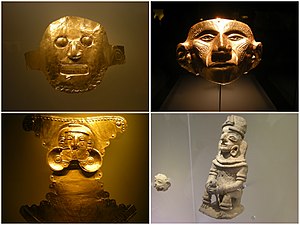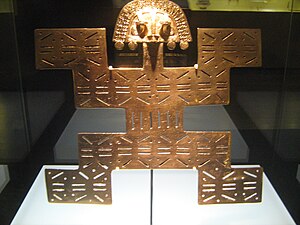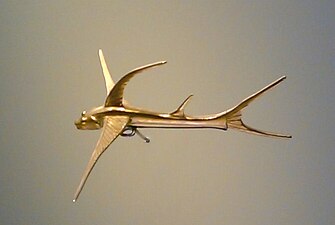Gold Museum, Bogotá
This article needs additional citations for verification. (January 2014) |
 | |
 View of the Museum of Gold | |
 Interactive fullscreen map | |
| Established | 22 December 1939 |
|---|---|
| Location | Carrera 6 # 15-82 (Parque Santander) Bogotá, |
| Coordinates | 4°36′6.91″N 74°4′19.20″W / 4.6019194°N 74.0720000°W |
| Director | María Alicia Uribe Villegas |
| Public transit access | |
| Website | www |


The Museum of Gold (Spanish: Museo del Oro) is an archaeology museum located in Bogotá, Colombia. It is one of the most visited touristic highlights in the country.[1] The museum receives around 500,000 tourists per year.[2]
The museum displays a selection of pre-Columbian gold and other metal alloys, such as Tumbaga, and contains the largest collection of gold artifacts in the world in its exhibition rooms on the second and third floors. Together with pottery, stone, shell, wood and textile objects, these items, made of a– to indigenous cultures – sacred metal, testify to the life and thought of the different societies which lived in present-day Colombia before the Spanish conquest of the Americas.
History
[edit]In 1934, the Bank of the Republic began helping to protect the archaeological patrimony of Colombia.[citation needed] The object known as Poporo Quimbaya was the first one in a collection. It has been on exhibition for 70 years.[when?] The museum is today administered by Banrepcultural.[3]
The museum houses the famous Muisca golden raft found in Pasca in 1969, that represents the ceremony of the new zipa (ruler) of Muyquytá, the basis for the El Dorado myth. The heir to the chieftaincy assumed power with a great offering to the gods. In this representation he is seen standing at the centre of a raft, surrounded by the principal chieftains, all of them adorned with gold and feathers.
After a decade of work, the museum was expanded and renovated in October 2008. With the renovation, the museum organized the permanent exhibition in five rooms with archaeological objects and an interactive room. It also added an auditorium, some temporary exhibitions rooms, a cafe, a restaurant, and a souvenir store.
Description
[edit]The museum has a collection of 55,000 pieces, 6,000 of which are on display in their expanded building. There are bilingual descriptions of almost all exhibits. On the first floor houses the museum's main entrance, a shop, and a restaurant.
Exhibitions begin on the second floor. The main room is called "People and Gold in pre-Hispanic Colombia". In glass vitrines display goldsmiths' work from the different cultures which inhabited Colombia before the Spanish colonists arrived. The permanent exhibition is divided into different halls for every culture: Calima, Quimbaya, Muisca, Zenú, Tierradentro, San Agustín, Tolima, Tairona, and Urabá, and a special room called "After Columbus" (Después de Colón).
The exposition continues on the third floor, with "The Flying Chamanic" and "The Offering." The first shows the process of a shamanic ceremony with its different gold pieces, the second is divided into three parts: the "Offering Room", the "Offering Boat", and the "Lake".
At the end of the exposition, there is a "Profunditation Room" with artistic videos about the most important gold pieces of the museum.
Gallery
[edit]-
The Muisca raft is the main piece in the Offering Boat Room
-
Gold pieces
-
Pectoral Tolima culture
-
Golden mask
-
Muisca golden sea snail
-
Golden fish
-
Golden plate
-
Golden figure
See also
[edit]- Calima culture
- Calima Gold Museum
- Colombian mythology
- Indigenous peoples in Colombia
- Muisca
- Muisca art
- Quimbaya civilization
- Quimbaya Museum
References
[edit]- ^ "The 22 Places To Go in Bogotá: Museum of Gold". Bogotá Travel Guide]. Retrieved 27 January 2014.
- ^ (in Spanish) Los 75 del Museo del Oro - Semana
- ^ "About Banrepcultural". Red Cultural del Banco de la República en Colombia. Retrieved 13 September 2018.
The cultural activity of Banco de la República extends as a network through 29 cities in the Colombian territory, and is carried out in the Gold Museum in Bogota, five Gold Museums in Armenia, Cali, Cartagena, Pasto and Santa Marta, the Ethnographic Museum in Leticia, the Luis Ángel Arango Library and the Casa Gómez Campuzano in Bogotá, the Library Network that extends through 28 Colombian cities, the Luis Ángel Arango Library Concert Hall, and Bogotá museums: Casa de Moneda, Botero Museum and, Miguel Urrutia Museum of Art (MAMU).
External links
[edit]- (in English) Official website
- (in Spanish) Official website
- The Art of Precolumbian Gold: The Jan Mitchell Collection, an exhibition catalog from The Metropolitan Museum of Art (fully available online as PDF), which contains material relevant to holdings at the Gold Museum
- Gold Museum, Bogotá within Google Arts & Culture
 Media related to Museo del Oro, Bogotá at Wikimedia Commons
Media related to Museo del Oro, Bogotá at Wikimedia Commons











